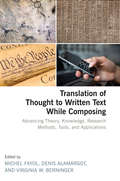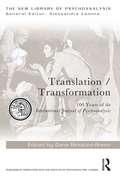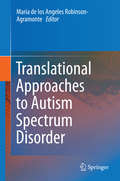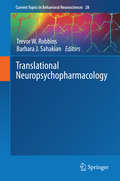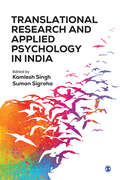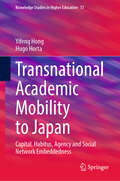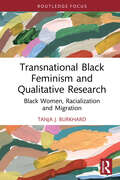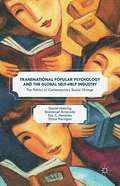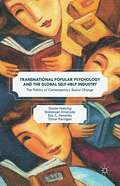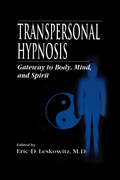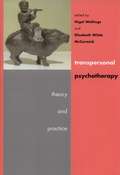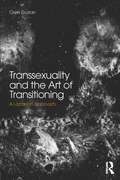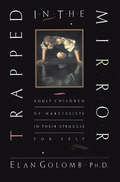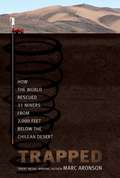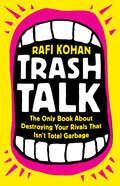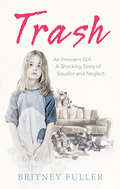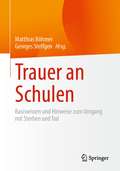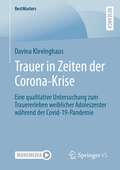- Table View
- List View
Translation of Thought to Written Text While Composing: Advancing Theory, Knowledge, Research Methods, Tools, and Applications
by Michel Fayol Denis Alamargot Virginia W. BerningerTranslation of cognitive representations into written language is one of the most important processes in writing. This volume provides a long-awaited updated overview of the field. The contributors discuss each of the commonly used research methods for studying translation; theorize about the nature of the cognitive and language representations and cognitive/linguistic transformation mechanisms involved in translation during writing; and make the case that translation is a higher-order executive function that is fundamental to the writing process. The book also reviews the application of research to practice -- that is, the translation of the research findings in education and the work-world for individuals who interact with others using written language to communicate ideas. This volume provides a rich resource for student, theorists, and empirical researchers in cognitive psychology, linguistics, and education; and teachers and clinicians who can use the research in their work.
Translation/Transformation: 100 Years of the International Journal of Psychoanalysis (The New Library of Psychoanalysis)
by Dana Birksted-BreenTranslation is at the heart of psychoanalysis: from unconscious to conscious, experience to verbal expression, internal to enacted, dream thought to dream image, language to interpretation, unrepresented to represented and transference of past to present. The book’s first part discusses the question of translation, literal and metaphoric. Both linguistic and cultural translations are closely tied to specific and significant personalities who were involved in the early history of psychoanalysis and thus in the development of the IJP. There was a close relationship between the IJP and the visual arts via the Bloomsbury Group. The link between the visual arts and the IJP is indeed to be found in its logo, which is taken from a painting by Ingres. The second part of the book approaches transformations between psychoanalysis and the arts from conscious, unconscious and non-represented elements into non-verbal modes, specifically visual, poetic and musical; it also looks at the developments and transformations in psychoanalytic ideas about artistic expression as expressed within the pages of the IJP. This book will be of great interest to psychoanalysts and psychotherapists, and to those interested in the history of psychoanalysis and the IJP.
Translational Anatomy and Cell Biology of Autism Spectrum Disorder
by Michael J. Schmeisser Tobias M. BoeckersAutism spectrum disorder (ASD) affects approximately 1 % of the human population and is characterized by a core symptomatology including deficits in social interaction and repetitive patterns of behaviour plus various co-morbidities. Although a lot of progress has been made to uncover underlying causes and mechanisms throughout the last decade, we are still at the very beginning to understand this enormously complex neurodevelopmental condition. This special volume is focused on translational anatomy and cell biology of ASD. International experts from the field including several members of the EU-AIMS initiative launched by the European Union to develop novel treatments for ASD have contributed chapters on several topics covering all crucial aspects of translational ASD research with a special emphasis on ASD model systems including stem cells and animals. Primary objective is to clarify how anatomical and cell biological phenotypes of ASD will help to translate basic mechanisms to clinical practice and to efficiently treat affected individuals in the near future.
Translational Approaches to Autism Spectrum Disorder
by Maria de los Angeles Robinson-AgramonteThis book addresses and synthesizes recent basic, translational, and clinical research with the goal of understanding the mechanisms behind autism spectrum disorder (ASD) and how they lead to altered brain function and behavior. Bringing clarity to these mechanisms will lead to more effective therapies for the various heterogeneous pathologies that comprise ASD. Currently there are few, if any, proven therapies for the majority of the disorders. Among the topic addressed are neural plasticity, neuroimmunology, neuroinflammation, neuroimaging, and appropriate animal and genetic models.
Translational Medicine and Drug Discovery
by Bruce H. Littman Rajesh KrishnaThis book, edited by two innovative leaders in the field, focuses on the new discipline of translational medicine as it pertains to drug development within the pharmaceutical and biotechnology industry. Translational medicine seeks to translate biological and molecular knowledge of disease and how drugs work into innovative development strategies that reduce the cost and increase the speed of delivering new medicines for patients. This book outlines general strategies, biomarker development, imaging tools, translational human models and examples of their application to real drug development. The latest thinking is presented by researchers from many of the world's leading drug development companies, including Pfizer, Merck, Eli Lilly, Abbott and Novartis, as well as academic institutions and public-private partnerships that support translational research. This book is essential for anyone interested in translational medicine from a variety of backgrounds: university institutes, medical schools, pharmaceutical companies and drug development researchers and decision-makers.
Translational Neuropsychopharmacology
by Trevor W. Robbins Barbara J. SahakianThis book covers wide areas of animal and human psychopharmacology with clinical utility in the treatment of psychiatric and neurological (e. g Alzheimer's disease) disorders. The main theme is to develop a new paradigm for drug discovery that questions the claim that animal models or assays fail adequately to predict Phase 3 clinical trials. A new paradigm is advocated that stresses the importance of intermediate staging points between these extremes that depend on suitable translation of findings from animal studies to Phase 1 or Phase 2 studies utilising experimental medicine.
Translational Neuroscience:
by Michael Williams James E. Barrett Joseph T. CoyleTranslational neuroscience is at the heart of clinical advancement in the fields of psychiatry, neurology and neurodevelopmental disorders. Written and edited by leading scientists and clinicians, this is a comprehensive and authoritative analysis of this emerging strategy for developing more effective treatments for brain disorders. Introductory chapters bring together perspectives from both academia and industry, while subsequent sections focus on disease groups, including bipolar disorder and depression, attention deficit hyperactivity disorder, substance abuse, autism, Alzheimer's disease, pain, epilepsy, Parkinson's disease and multiple sclerosis. Each section includes topical introductory and summary chapters, providing an overview and synthesis of the field. Translational Neuroscience: Applications in Neurology, Psychiatry, and Neurodevelopmental Disorders is an important text for clinicians, scientists and students in academic settings, government agencies and industry, as well as those working in the fields of public health and the behavioural sciences.
Translational Research and Applied Psychology in India
by Kamlesh Singh Suman SigrohaTranslational research (TR) is the means by which the knowledge gained through basic scientific research can be implemented specifically for achieving a better quality of life. It seeks to provide a pathway for ideas to quickly reach the implementation stage. TR has now been extended to social sciences, such as applied psychology, where focused TR is underway in several areas, such as happiness, mental health and well-being, promoting positive cultural practices and intervention programmes. Translational Research and Applied Psychology in India focuses on research translated into real-world awareness programmes in various settings—corporate workplaces, educational, religious and social institutions, and rural areas—and even web-based interventions that are facilitating improvement in people’s daily lives. This comprehensive overview of theoretical frameworks and programmes will help further functional knowledge and identify barriers between theory, practice and policy, besides bridging those barriers. The book is of critical importance due to the ever-increasing socio-economic differences and other related disparities that lead to ever-widening gaps in healthcare access and other such public concerns.
Transnational Academic Mobility to Japan: Capital, Habitus, Agency and Social Network Embeddedness (Knowledge Studies in Higher Education #17)
by Hugo Horta Yifeng HongThis book addresses agency and habitus development of migrant academics in Japan and reveals the complexity of international academic mobility in East Asian contexts. It addresses differentiated transnational academic mobility routes and route-confined capitals and dispositions, the effect of stratified social networks and network embeddedness on international academic mobility, and the effect of unequal globalization and the asymmetrical internationalization of international academic mobility. The book highlights the roles of transnationally stretched social network development and network embeddedness along life trajectories, locating them as critical infrastructures of mobilities and identifying an array of individual social network building and maintenance strategies and principles. It illustrates how familial, educational, academic and social networks across borders facilitate and channel flows of capitals and resources vital for academic performance and upward academic mobility of migrated academics. It draws on a range of theoretical frameworks of Bourdieusian theory of sociology, transnationalism and qualitative social network analysis. The research is based on 26 case studies of migrant scholars in Japan, using narrative inquiry and qualitative social network analysis. The work provides multiple implications for practitioners, policy makers and researchers who seek answers to the sustainability of the internationalization of higher education in Asia Pacific and emerging higher education hubs.
Transnational Black Feminism and Qualitative Research: Black Women, Racialization and Migration
by Tanja J. BurkhardTransnational Black Feminism and Qualitative Research invites readers to consider what it means to conduct research within their own communities by interrogating local and global contexts of colonialism, race, and migration. The qualitative data at the centre of this book stem from a yearlong qualitative study of the lived experiences of Black women, who migrated to or spent a significant amount of time in the United States, as well as from the author's experiences as a Black German woman and former international student. It proposes Transnational Black Feminism as a framework in qualitative inquiry. Methodological considerations emerging from and complementary to this framework critically explore qualitative concepts, such as reciprocity, care, and the ethics with which research is conducted, to account for shifts in power dynamics in the research process and to radically work against the dehumanization of participants, their communities, and researchers. This short and accessible book is ideal for qualitative researchers, graduate students, and feminist scholars interested in the various dimensions of racialization, coloniality, language, and migration.
Transnational Popular Psychology and the Global Self-Help Industry: The Politics of Contemporary Social Change
by Daniel Nehring Dylan Kerrigan Emmanuel Alvarado Eric C. HendriksSelf-help books aim to empower their readers and deliver happiness and personal fulfilment but do they really live up to this? This book offers a fresh perspective on self-help culture and popular psychology. Research on this subject matter has generally focused on the USA and the Global Northwest. In contrast, this book explores the production, circulation and consumption of self-help books from an innovative transnational perspective. Case studies on Trinidad, Mexico, the People's Republic of China, the UK and the USA explore the roles which self-help's therapeutic narratives of self and social relationships play in the contemporary world. In this context, the book questions the extent to which self-help fulfils its promise of individual autonomy and contentment. At the same time, it addresses debates about contemporary political change under transnational processes of cultural standardization.
Transnational Popular Psychology and the Global Self-Help Industry: The Politics of Contemporary Social Change
by Daniel Nehring Dylan Kerrigan Emmanuel Alvarado Eric C. HendriksSelf-help books aim to empower their readers and deliver happiness and personal fulfilment but do they really live up to this? This book offers a fresh perspective on self-help culture and popular psychology. Research on this subject matter has generally focused on the USA and the Global Northwest. In contrast, this book explores the production, circulation and consumption of self-help books from an innovative transnational perspective. Case studies on Trinidad, Mexico, the People's Republic of China, the UK and the USA explore the roles which self-help's therapeutic narratives of self and social relationships play in the contemporary world. In this context, the book questions the extent to which self-help fulfils its promise of individual autonomy and contentment. At the same time, it addresses debates about contemporary political change under transnational processes of cultural standardization.
Transpersonal Hypnosis
by Eric D. LeskowitzTranspersonal Hypnosis presents a multidimensional, energy-based view of human awareness that integrates disparate biological, psychological, and spiritual therapeutic techniques. Each of the chapters - all from world-renowned contributors - includes both a historical overview and the theory behind the development of each technique. The authors emphasize experimental studies that examine the validity of using hypnotically accessed transpersonal states of consciousness to heal the body, mind, and spirit. Several clinical vignettes highlight the types of medical and psychological symptoms responsive to these approaches. The emerging field of spiritually-influenced treatments is transforming the practice of medicine.
Transpersonal Psychotherapy
by Nigel Wellings Elizabeth Wilde McCormick`This is an enriching book for readers interested in unconscious psychological processes and who have a predilection for psychotherapy which interfaces psychology, philosophy and spirituality′ - Journal of Critical Psychology, Counselling and Psychotherapy Transpersonal Psychotherapy recognizes levels of experience that take us beyond our usual sense of self, limited by the content of our personality. Whilst facilitating the emergence of self, it also actively encourages an exploration of transpersonal experience as an integral part of the individuation process. The major work proves a thorough and accessible introduction for students of psychotherapy ad interested others.
Transplant Psychiatry: A Case-Based Approach to Clinical Challenges
by Yelizaveta Sher Paula C. Zimbrean Catherine Crone Andrea F. DiMartiniThis book addresses the challenges clinicians face when working with patients facing complicated medical diagnosis for which transplantation is considered. Written by experts in transplant psychiatry, each chapter approaches a common psychiatric challenge faced by transplant candidates and recipients. Chapters meticulously share clinical expertise that provides a framework for future discussions without neglecting the fact that each transplant patient is unique in the complexity of their medical diagnosis. Additionally, the book examines complex issues including transplant-related posttraumatic stress disorder, post-transplant cognitive impairment, the collaboration between mental health and transplant clinicians, substance use and a wide range of other complicated topics.Transplant Psychiatry is an excellent case-based guide to mental healthcare delivery for all clinicians who may work with transplant patients, including psychiatrists, psychologists and mental health professionals, transplant surgeons, internal medicine specialists, hematologists, transplant social workers and transplant coordinators.
Transsexuality and the Art of Transitioning: A Lacanian approach
by Oren GozlanWinner of The American Board and Academy of Psychoanalysis (ABAPsa) Book Prize for 2015 Transsexuality and the Art of Transitioning: A Lacanian approach presents a startling new way to consider psychoanalytic dilemmas of sexual difference and gender through the meeting of arts and the clinic. Informed by a Lacanian perspective that locates transsexuality in the intermediate space between the clinic and culture, Oren Gozlan joins current conversations around the question of sexual difference with the insistence that identity never fully expresses sexuality and, as such, cannot be replaced by gender. The book goes beyond the idea of gender as an experience that gives rise to multiple identities and instead considers identity as split from the outset. This view transforms transsexuality into a particular psychic position, able to encounter the paradoxes of transitional experience and the valence of phantasy and affect that accompany aesthetic conflicts over the nature of beauty and being. Gozlan brings readers into the enigmatic qualities of representation as desire for completion and transformation through notions of tension, difference and aesthetics through examining the artwork of Anish Kapoor and Louise Bourgeois and the role played by confusion in the aesthetics of transformation in literature and memoir. Each chapter of the book presents a productive take on understanding the psychoanalytic demand to sustain and consider the dilemma that the unconscious presents to the knowledge and recognition of gender. Fundamentally, this work understands transsexuality as a creative act, rich with desire and danger, in which thinking of the transsexual body as both an analytic and a subjective object helps us to reveal the creativity of sexuality. Ideal for psychoanalysts, psychologists, psychiatrists and social workers as well as students of psychoanalysis, cultural studies, literature studies and philosophy, Transsexuality and the Art of Transitioning offers a unique insight into psychoanalytic approaches to transsexuality and the question of assuming a position in gender.
Transvestism, Transsexualism in the Psychoanalytic Dimension (The International Psychoanalytical Association Controversies in Psychoanalysis Series)
by Giovanna AmbrosioThis book is an outcome of the European Conference on the theme of transsexualism held in Catania, Italy in 2006. It shows how psychoanalysis can reflect, discuss, dialogue and formulate useful insights on one of the most challenging situations that confront the mental health community.
Trapped in the Mirror
by Elan ColombIn this compelling book, Elan Golomb identifies the crux of the emotional and psychological problems of millions of adults. Simply put, the children of narcissist -- offspring of parents whose interest always towered above the most basic needs of their sons and daughters -- share a common belief: They believe they do not have the right to exist. The difficulties experienced by adult children of narcissists can manifest themselves in many ways: for examples, physical self-loathing that takes form of overeating, anorexia, or bulimia; a self-destructive streak that causes poor job performance and rocky personal relationships; or a struggle with the self that is perpetuated in the adult's interaction with his or her own children. These dilemmas are both common and correctable, Dr. Golomb tells us. With an empathic blend of scholarship and case studies, along with her own personal narrative of her fight for self, Dr. Golomb plumbs the depths of this problem, revealing its mysterious hold on the affairs of otherwise bright, aware, motivated, and worthy people. Trapped in the Mirror explores. * the nature of the paralysis and lack of motivation so many adults feel * stress and its role in exacerbating childhood wrongs * why do many of our relationships seem to be "reruns" of the past * how one's body image can be formed by faulty parenting * how anger must be acknowledge to be overcome * and, most important, how even the most traumatized self can be healed. Rooted in a profoundly humanist traditional approach, and suffused with the benefit of the latest knowledge about intrafamily relationships, Trapped in the Mirror offers more than the average self-help book; it is truly the first self-heal book for millions.
Trapped: How the World Rescued 33 Miners from 2,000 Feet Below the Chilean Desert
by Marc AronsonThe amazing story of the trapped Chilean miners and their incredible rescue that Publishers Weekly calls "a riveting, in-depth recounting of the events that held the world rapt."In early August 2010, the unthinkable happened when a mine collapsed in Copiano, Chile, trapping 33 miners 2,000 feet below the surface. For sixty-nine days they lived on meager resources with increasingly poor air quality. When they were finally rescued, the world watched with rapt attention and rejoiced in the amazing spirit and determination of the miners. What could have been a terrible tragedy became an amazing story of survival. In Trapped, Marc Aronson provides the backstory behind the rescue. By tracing the psychological, physical, and environmental factors surrounding the mission, Aronson highlights the amazing technology and helping hands that made it all possible. From the Argentinean soccer players that hoped to raise morale, to NASA volunteering their expertise to come up with a plan, there was no shortage of enterprising spirit when it came to saving lives. Readers will especially appreciate the eight pages of full-color photos, timeline, glossary, notes, and more.
Trapped: How the World Rescued 33 Miners from 2,000 Feet below the Chilean Desert
by Marc AronsonIn early August 2010, the unthinkable happened when a mine collapsed in Copiapó, Chile, and 33 miners were trapped 2,000 feet below the surface. For sixty-nine days they lived on meager resources and increasingly poor air quality. When they were finally rescued, the world watched with rapt attention and rejoiced in the amazing spirit and determination of the miners. What could have been a terrible tragedy became an amazing story of survival. Now, with exclusive interviews with rescuers and expert commentary, Marc Aronson brings us the backstory behind this incredible event. By tracing the psychological, physical, and environmental factors surrounding the rescue, Trapped highlights the amazing technology and helping hands that made it all possible. From the Argentinean soccer players who hoped to raise morale, to NA SA volunteering their expertise to come up with a plan, there was no shortage of enterprising spirit when it came to saving lives.
Trash Talk: The Only Book About Destroying Your Rivals That Isn't Total Garbage
by Rafi Kohan&“You&’re mad at me, but I am killing you.&”—NBA star Gary Payton&“Find the hate.&”—NFL star Warren Sapp&“Why can&’t you be more like Rafi Kohan?&”—your mom, probably Whether in basketball, football, or MMA, athletes talk trash to each other—and sometimes to fans—like it&’s their job. And in some ways, it is: sports only matter if we decide to care about them. And insulting your opponent, or playing the heel, is probably the fastest route to making someone care. Talking smack is as old as the bible; it&’s perhaps the original sport. But until now, there&’s never been a book about it. In this lively, often hilarious history, Rafi Kohan interviews some of the world&’s top competitors—on the petty rivalries and mind games that fuel them. He talks to point guards and soccer strikers, cricketers and insult comedians, forming a theory along the way about the surprising and influential role that name-calling plays in our world. Brilliantly original and wide-ranging, Trash Talk is a book for sports fans, culture mavens, or anyone looking to get an edge.
Trash: An Innocent Girl. A Shocking Story of Squalor and Neglect.
by Britney Fuller‘To start: it was just me and my mom. I am an only child, and she is a single parent. My mother is a trash hoarder. Ever since I can remember the house was always messy and stunk. At around age 9ish I noticed that something was wrong. I started throwing bags of trash away every day, just to have my mom freak out when she got home. We didn’t eat at home anymore because the fridge was disgusting, and she used the sink as a trash can, so it got clogged. We always ate out, we never had a home-cooked meal, and I’ve never had a family dinner at a dinner table. I had a stool in the corner of the living room. That is what I sat on, and that alone. I kept that corner as clean as I could. Made sure there was foot space, and that there wasn’t dust on the walls. That was my corner, my space. It never seemed to matter though, eventually that spot would get overrun with trash too...’Trash is Britney Fuller's shocking account of growing up in the house of a hoarder.
Trastorno bipolar: el enemigo invisible ( Manual de tratamiento psicológico)
by Ana González IsasiEl objetivo principal de esta manual es ofrecer un programa de tratamiento psicológico que, junto al tratamiento farmacológico, reduzca las hospitalizaciones y las recaídas, y mejore la calidad de vida y la recuperación funcional de los pacientes con trastorno bipolar o con trastorno bipolar refractario.El tratamiento farmacológico ha sido, hasta hace pocos años, el único tratamiento ofertado a los pacientes con un trastorno bipolar, mostrándose insuficiente en una gran proporción de casos. En los últimos años se ha investigado la influencia de diferentes terapias psicosociales en el trastorno bipolar, apostando por la necesidad de un programa estructurado que combinara técnicas de distintos modelos. Por ello, presentamos un programa de tratamiento psicológico de veinte sesiones para ser aplicado en formato grupal, que integra psicoeducación con terapia cognitivo-conductual y añade técnicas de otros modelos. Este programa se desarrolla en el medio clínico habitual de los pacientes, por lo que puede ponerse en práctica tanto en hospitales como en centros de salud mental. Este manual pretende ofrecer a los profesionales un amplio repertorio de estrategias útiles y prácticas para mejorar la evolución de nuestros pacientes. El presente volumen se completa con la obra Ojos que si ven. Soy Bipolar. (Diez entrevistas) (Ed. Desclée De Brouwer. Colección Serendipity. Bilbao 2011), un compendio de diez entrevistas de corte humano con pacientes bipolares que participaron en esta experiencia científica.Ana González Isasi (Vitoria-Gasteiz, 1977). Doctora en Psicología por la Universidad del País Vasco. Se especializó en Psicología Clínica en el Hospital Santiago Apóstol de Vitoria-Gasteiz, y trabaja desde hace seis años en el Hospital Universitario Insular de Gran Canaria dedicándose a la asistencia, docencia e investigación. Ha publicado artículos de difusión nacional e internacional, ha participado en varios congresos y ha impartido cursos a profesionales sanitarios sobre el manejo del trastorno bipolar.
Trauer an Schulen: Basiswissen und Hinweise zum Umgang mit Sterben und Tod
by Matthias Böhmer Georges SteffgenDas Buch befasst sich mit dem Umgang mit Trauer an Schulen. Es werden Trauerreaktionen von Kindern und Jugendlichen beschrieben und Trauergründe dargestellt: Tod aufgrund einer chronischen Erkrankung, plötzliche Todesfälle wie Suizid, Unfall und schwere zielgerichtete Gewalt. Entsprechende Interventionsmaßnahmen werden vorgestellt. Abschließend wird auf die Grenzen dieser Interventionsmaßnahmen in der Schule eingegangen.
Trauer in Zeiten der Corona-Krise: Eine qualitative Untersuchung zum Trauererleben weiblicher Adoleszenter während der Covid-19-Pandemie (BestMasters)
by Davina KlevinghausDie Covid-19-Pandemie tangiert das Alltagserleben zahlreicher junger Menschen in Deutschland mitunter gravierend. Wie kann es unter diesen Umständen gelingen, die Trauer nach dem Verlust einer nahestehenden Person in ein von Unabwägbarkeiten und radikalen Veränderungen geprägtes Leben zu integrieren? Welche Belastungen und Ressourcen rücken in Anbetracht der ubiquitären Bedrohung durch das Coronavirus besonders in den Fokus? Auf diese Fragen sowie auf weitere Spezifika des Trauererlebens weiblicher Adoleszenter im Zuge der Pandemie wird - rekurrierend auf Bezugstheorien der Trauer- und Stressforschung - der Schwerpunkt der vorliegenden Arbeit gerichtet. Die geführten Interviews deuten auf erhebliche interindividuelle Unterschiede im Pandemie- und Verlusterleben sowie in den Verarbeitungsformen der eigenen Trauer hin. Zugleich lassen sich zahlreiche geteilte Erfahrungen rekonstruieren. Insofern bieten die Analysen einen grundlegenden Reflexionsanlass im Hinblick auf die Partizipationsmöglichkeiten junger Menschen, den Zugang zu trauerbezogenen Unterstützungsangeboten sowie auf den gesamtgesellschaftlichen Umgang mit Sterben, Tod und Trauer.
